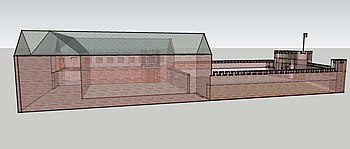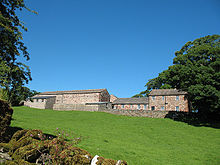|
Hartley Castle
Hartley Castle was a castle near Kirkby Stephen, Cumbria, England. HistoryThe manor was confiscated circa 1315 from Roger de Clifford and granted to Andrew de Harcla (anglicized to Andrew de Harclay or Hartley). The name Harcla is thought to be from the Old English for "hard ground" and may refer to the outcrop of land that the castle is built upon in the Eden valley. The existing manor house was fortified by de Harcla, some time prior to 1323, when he was ordered by King Edward II to be hanged, drawn and quartered for alleged collusion with Robert the Bruce, and forfeited his earldom and lands. It was granted to Ralph de Neville who later sold it through three other hands to Thomas de Musgrave who on 4 October 1353 was granted a licence to crenellate by King Edward III:
It was improved during the 17th century with the addition in 1615 of a pair of wings but was abandoned circa 1677. Thomas Machel visited the castle in 1677 and described it as
 Another sketch from 1692 shows a thick, high curtain wall enclosing a square outer court, with an inner court enclosed by three and four storey buildings. The image at right shows what remained by the beginning of the 18th century. It was demolished between 1704 and 1744 for building stone which was used to repair Edenhall. The castle layout appears to have been similar to Sudeley Castle in the Cotswolds, with its double courtyards separated by a low dividing wall and a central small door and its oriel-windowed hall, but without Sudeley's later Southern Wing and with a curtain wall demarking the second courtyard instead.  Today Apart from limited earthworks, all that remains now is a few metres of wall and stairs down to a vaulted cellar for the former kitchen. The site currently houses a late-18th-century farmhouse and outbuildings. See also
References
External links |
||||||||||||||||||||||||||
Portal di Ensiklopedia Dunia


